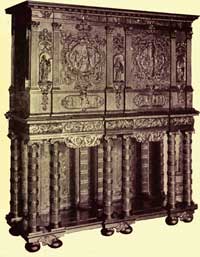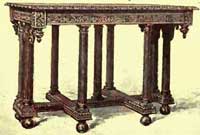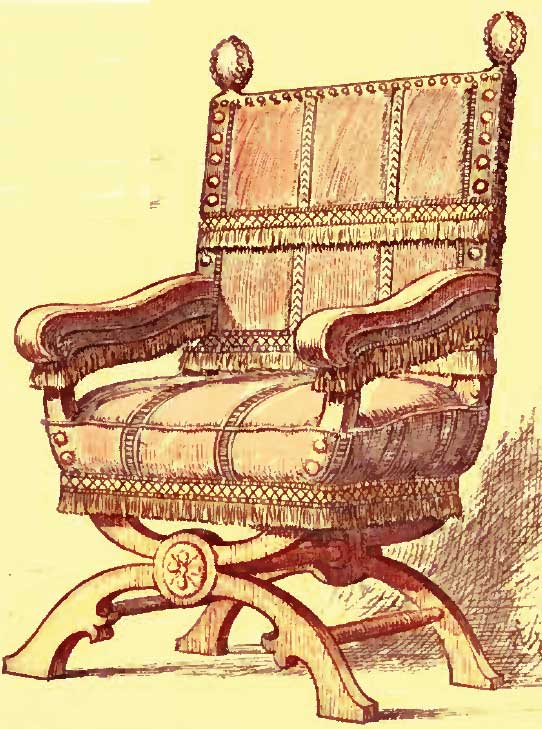Louis XIII Furniture Style
The Louis XIII style is associated with Rubens’ arrival in France in 1621. Marie de' Medici commissioned Rubens to paint two allegorical cycles for the Luxembourg Palace in Paris, celebrating her life and the life of his late husband, Henry IV. The works were completed in 1625, and the commencement of Rubens’ visit is generally considered as the beginning of the Louis XIII style. Therefore, the Louis XIII furniture will have as a main characteristic the Flemish influence.
Marie de' Medici employed many Italian artists to design the pieces of the new style. Louis XIII is still a Renaissance style, as Rubens himself had spent eight years in Mantua, his designs showing a fusion of Flemish and Italian influences. However, with the Louis XIII style, the Italian taste is secondary to the Flemish one.
A good part of the furniture of the period was designed by goldsmiths, who were very influential in decorative arts. Architects were also main designers of furniture. They designed the important pieces, which were considered an integral part of interior decoration.

Louis XIII Style - Ebony Chest
The Louis XIII furniture is characterized by dark tones. The marquetry consists of metal, wood and tortoise-shell. The ornaments include the round, inflated cartouche, with a convex curve, massive balusters, twisted columns, or garlands of fruits like apples and pears, with few leaves.
Louis XIII cabinets
The early Louis XIII style cabinets are architectural in form, with greater width than height. They rest on a frame with spiralled turned legs. The massive wardrobes, cabinets, and armoires are severe and heavy, in two tiers, with the lower one usually solid. An open lower part came into favour later.
Generally, panelling was an important part in furniture decoration. The panels were richly carved, sometimes using Biblical, allegorical or mythological subjects. The pillars were straight or twisted. The flat bulb foot, plain or carved, is typical for the Louis XIII furniture.
The woods of which the massive cabinets and chests of drawers were made were oak, walnut, chestnut and sometimes ebony.
The cabinets of the Louis XIII period made by Italian artists were sumptuous, with pilasters of lapis-lazuli, plates of embossed silver, paintings and miniatures. The "cabinets a porte" (cabinets with doors) were more severe, and more architectural.
Beds of the Louis XIII period
The bed is highly decorative, with the wooden frame seldom visible. The posts of the canopy are covered with the same material as the curtains, painted, or sometimes, plain. A bed was covered with various materials, from tapestry, brocade, damask, silk, velvet, to serge, cloth, or linen.
Another characteristic bed of the period was the "lit de baldaquin", a bed with dais on three sides. Its frame was of natural wood, wood carved and gilded, or covered with rich material. The baldaquin replacing the canopy and supported by posts was slightly smaller than the bed.
Chairs
The Louis XIII style set of seats contained fauteuils, or arm-chairs, chairs, folding-stools and the "lit de repos." The most characteristic chair was square, sometimes short, and is best illustrated in the drawings of Abraham Bosse. In England, this type of chair became known as "the low leather," or "Cromwell chair." It was covered with leather, serge, silk, damask, brocade, velvet, tapestry, or even needlework. The material was fastened to the woodwork by large gold, brass, or silver-headed nails, with the back and seat usually ornamented with a short fringe.

Louis XIII Style - Table
Many of the fauteuils were entirely covered with velvet and decorated with lace or fringe, a fashion inspired by the Italian taste. The frame of the arm-chair could be of pear-wood stained black, walnut, oak, or it was painted in a colour in harmony with the covering. A favourite shape for the chairs legs was the X shape, as depicted in the paintings of the Dutch masters. These chairs were of Flemish and Italian origin.
The Genoa and Venetian velvets, with floral designs in high relief, were also popular as coverings for the fauteuils or folding-seats.
Tables
The Louis XIII tables were richly carved, or with the wood gilded, with the legs with or without stretchers. They could also be enriched with gilded bronze, marquetry, or shell work, with many table tops made of marble or marquetry.
The tables were usually covered with a cloth and a housse of leather, serge, or tapestry. The cover reached to the floor and was garnished with fringe. Above the housse a second cloth was used.
During the reign of Louis XIII, the “table en console” appears in the inventories. Gradually, the term table was dropped from the name, the piece being known simply as console. The console was derived from the credence, and, especially in the early days, the carving of the legs was displaying mythological subjects, like chimaeras or fauns.
A very popular Louis XIII style table was the gueridon, a small round table mounted on a baluster ending in three legs. It was made of various woods. When pear-wood was used, it was stained black, or painted.

